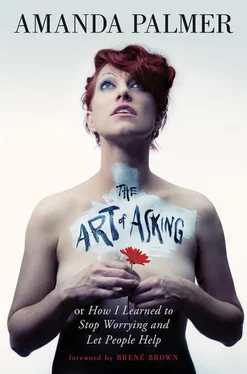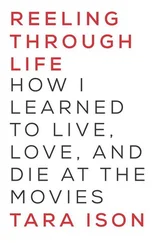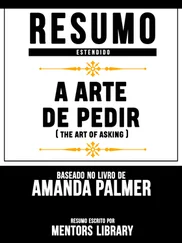All my parents, stepparents, and exes-of-stepparents, the whole lot of them, looked crazy to me. Why keep getting married and divorced, people? Why not just DATE?
I would not make their mistake. Even if I was in love.
I wanted to be free. Unfettered.
Marriage always looked like hell to me.
• • •
When a stranger put money into the hat, I would try to emanate an immense amount of gratitude for this savior who had momentarily freed me from my frozen pose. I wouldn’t look at the donor immediately. I would be coy. I would look at the sky. I would look at the crowd. I would look at the street. I would look at my vase. And then, once I had selected the perfect flower with as much graceful fluidity as possible, I would finally gaze at my new friend, never smiling with my mouth but always with my eyes, and lean my body forward ever so slightly, holding out the flower delicately clutched between my thumb and forefinger.
This always reminded me of the act of communion: that small, quiet, intimate moment when the priest proffers the wafer, intimately instructing you to ingest the body of Christ. (I was pretty bored in church as a kid, but I always loved that ritual. I also liked the singing bits.)
So, a dollar into the hat. I would gaze lovingly at my new human friend, my head filling up with a little silent monologue that sounded something like this:
The body of Christ, the cup of salvation .
Regard this holy flower, human friend .
Take it, it’s for you. A gift from my heart .
Oh, you want a picture? Okay! We can take a picture .
I’ll just hold this flower and wait while your girlfriend gets out her camera .
The body of Christ, the cup of salvation. The flower of patience .
Oh. I see your girlfriend’s camera batteries are dead .
Now your other friend is getting his camera out .
This is all fine. Because I am the picture of Zen and in the moment .
The body of Christ, the cup of salvation, the flower of forgiveness .
So come to me, human friend! Nuzzle into the folds of my white gown, we will pose together. With love .
Oh, new human friend, your friend with the camera is drunk, isn’t he?
May he find peace. May he find solace. May he find the shutter button .
Okay. Now you finally have your picture and you have high-fived your drunken friend .
Now please take this flower I have been holding out to you. My sacrament .
The body of Christ, the cup of salvation, the flower of oneness and joy and…
HEY .
Why are you walking away?
I have a flower for you!
A gift! A holy token of love!
The body of Christ!!
TAKE THE FUCKING FLOWER .
For real, dude… you don’t want my flower?
Jesus okay fine .
I will just hang my head in sorrowful shame for all that is wrong with the world .
As he walked away, I would hang my head in sorrowful shame for all that was wrong with the world.
And if I was, by my own estimation, nailing my job, everybody watching this interaction on the sidewalk would shout after the dude, as he walked away with his drunk friend and girlfriend:
HEY! HEY YOU!! SHE’S GOT A FLOWER FOR YOU!!! TAKE THE FLOWER!!!!
The dude would usually bend to the peer pressure and come back to take it. But not always.
Sometimes I just had to let him go.
Girls, for the record, almost always took the flower. The ones who refused? Sometimes they seemed to think they were doing me a favor by rejecting the flower, gesturing:
No, no! I couldn’t possibly! Keep it for someone else!
But they didn’t understand that they were breaking my heart. Gifting them my flower—my holy little token—was what made me feel like an artist, someone with something to offer, instead of a charity case.
Over the years, though, I got used to it, and instead of taking it personally, I began to understand:
Sometimes people just don’t want the flower.
Sometimes you have to let them walk away.
• • •
Joshua Bell, a world-class violinist, teamed up with the Washington Post for a social experiment in which he played his $3.5 million Stradivarius one morning in the L’Enfant Plaza subway station in Washington, DC. During his performance, which ran about forty-five minutes, seven people stopped to listen for a minute or more, twenty-seven contributed money, and he made a total of $32 (not counting the $20 thrown in his hat by the one woman who recognized him). More than a thousand people had walked by him without stopping.
In the aftermath, it was easy for many people to shake their heads at the perceived shame of it all: how could music so valuable —some of these same people might be paying as much as $150 a ticket to watch him play the same program at the local symphony hall the following night—become so worthless on the street?
But if you watch the hidden camera footage of the stunt, and note the time of day (morning rush hour) and the demographics (busy government employees on their way to work), it starts to make more sense. Those mindless barbarians who had no idea what they were witnessing were commuters on their way to work who couldn’t afford to stop at that exact moment to appreciate art. Certain art hungers for context. We can’t blame these passersby; we can simply applaud and feel gratitude for the few people who slowed and cocked their heads, heard the voice of god speaking via Bach speaking via Josh Bell’s Stradivarius, and feel joy and hope that a few folks actually threw in a dollar or two.
As for me, it took a few months of hardcore statue work to really find my footing and develop this sense of deep gratitude for the sliver of the population, however small, that was willing to tune their head frequencies to the Art Channel for a moment, interrupting their march to work.
That ongoing sense of appreciation shaped my constitution in a fundamental way. I didn’t just feel a fleeting sense of thanks for each generous person who stopped; I had been hammered into a gratitude-shaped vessel and would never take for granted those willing to slow down and connect.
• • •
There is a certain sense of indiscriminate gratitude that is essential to hone if you’re going to survive in the arts. You can’t really afford to be choosy about your audience, nor about how they wish to repay you for your art. In cash? In help? In kindness?
Each of these currencies possesses a distinct value. Dita Von Teese, a star in the contemporary burlesque scene, once recounted something she’d learned in her early days stripping in LA. Her colleagues—bleach-blond dancers with fake tans, Brazilian wax jobs, and neon bikinis—would strip bare naked for an audience of fifty guys in the club and be tipped a dollar by each guy. Dita would take the stage wearing satin gloves, a corset, and a tutu, and do a sultry striptease down to her underwear, confounding the crowd. And then, though forty-nine guys would ignore her, one would tip her fifty dollars.
That man, Dita said, was her audience.
This is exactly what I learned standing on the box, then while playing in bars in my first band, and, later, when I turned to crowdfunding. It was essential to feel thankful for the few who stopped to watch or listen, instead of wasting energy on resenting the majority who passed me by.
Feeling gratitude was a skill I honed on the street and dragged along with me into the music industry. I never aimed to please everyone who walked by, or everyone listening to the radio. All I needed was… some people. Enough people. Enough to make it worth coming back the next day, enough to make rent and put food on the table. And enough so I could keep making art.
Читать дальше












